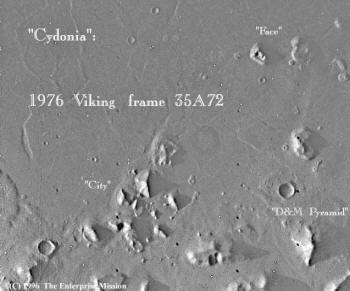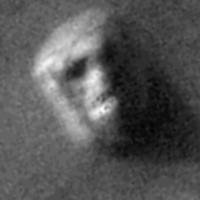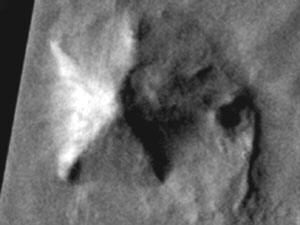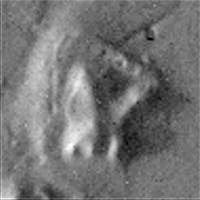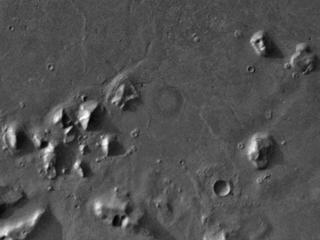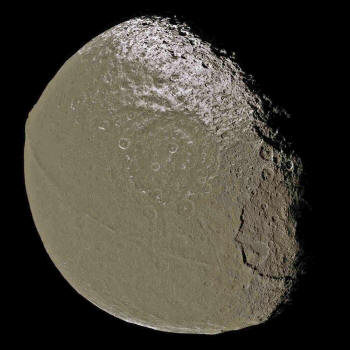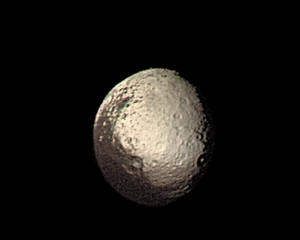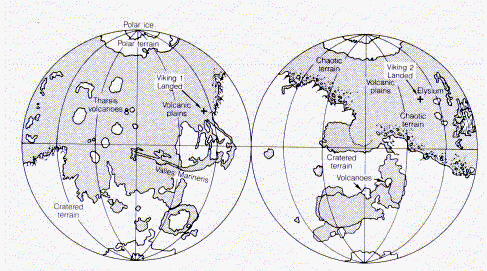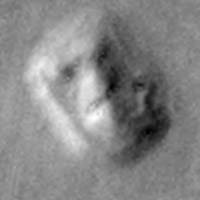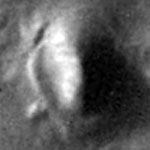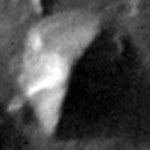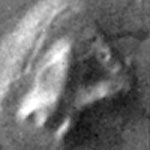|
|
|
The so-called "Face" on Mars and the surrounding anomalous objects in a region called "Cydonia" appear at first glance to be randomly located and oriented on the planet.
But it has previously been established that the martian poles had a different location with respect to the surface of the planet in the past, and apparently jumped from that location to the present one in relatively little geological time. We draw attention to the fact that the Cydonia area is right on the old martian equator, and the "Face" is oriented perpendicular to that old equator, to within the measurement uncertainties.
This has only about a 1% probability of occurring by chance.
Both the line of inquiry that led to this discovery and a possible purpose for building such an artificial structure looking into space were suggested by the exploded planet hypothesis. Taken in conjunction with the finding of bilateral symmetry in the Face and the anomalous nature of other nearby objects on Mars, the weight of existing evidence has, in this author's opinion, shifted in favor of an artificial origin of the Cydonia complex.
With luck, the Mars Global Surveyor spacecraft now en route to Mars will confirm or refute this conclusion.
Figure 1. Overview of Cydonia region on Mars. North is up. The frame height is about 1.5 degrees or 80 km.
Description of Cydonia
It was photographed several times by NASA's Viking Mars-orbiting spacecraft in the mid-to-late 1970s. One ground object drew the attention of researchers because of its striking resemblance to a human face. In the opinion of many who have viewed the higher resolution images, the resemblance is closer than seems likely to have arisen by chance, despite half the "face" being hidden in shadow. (See Figure 2.)
Because it is a three-dimensional "face" and not just a profile,
it has been described as the next best depiction of a human face in
stone on its (~ 1 kilometer) size scale in the explored solar system
after Mount Rushmore in South Dakota.
It has a more-than-passing resemblance to a four-sided, or possibly a five-sided, pyramid. The formation of a small crater seen very close to the base on the shadowed side has apparently thrown debris onto that side of the object, and possibly caused it to split or separate, leading to the ambiguity in the number of original apparent pyramidal faces.
But the three faces not coated with debris appear remarkably smooth and triangular, separated by seemingly linear edges.
Figure 2.
Close-up of the "Face" at Cydonia on Mars.
Figure 3. Close-up of "D&M pyramid" at Cydonia on Mars.
Figure 4. Close-up of "Fortress" at Cydonia on Mars.
Figure 5.
Close-up of "City" showing its relation to the "Face" and
"Fortress".
Still another nearby object has been dubbed the "Fortress" because of a modest resemblance to structures called that on Earth. (See Figure 4.)
Its linear features and sharp angles suggest artificiality to some. A nearby cluster of vaguely pyramidal objects surrounding some unusual small mounds not commonly seen away from Cydonia has been dubbed the "City". (See Figure 5.)
Two or perhaps
three other nearby features are each in its own way mildly anomalous
or unique on the planet. These may be viewed in (Carlotto, 1991), in
(DiPietro, Molenaar & Brandenburg, 1988), or on
http//www.psrw.com/~markc/marshome.html.
No unique
identifying characteristic seems to exist, as if both had a common
origin. Yet in standard models, asteroids originated in the inner
solar system and comets in the outer regions, and the two should be
quite chemically and spectrally distinct.
Mainstream astronomers were shocked when the Galileo spacecraft found a moon orbiting asteroid Ida in 1993.
Figure 6.
Saturn's half-bright, half-dark
moon Iapetus.
The explosion would have sent a blast wave of black, carbonaceous material through the entire planetary system.
In fact, airless bodies are coated by just such black residue precisely to the extent they could have been exposed to such a blast wave. The most striking example is Saturn's moon Iapetus, which spins so slowly (once per 80 days) that only one side could have been coated by the blast.
An unsolved mystery of long standing about Iapetus is why it is icy-bright on one side and coal black on the other. (See Figure 6.)
The two strongest lines of evidence are:
An example of the former is the expectation of a population of "new" comets close to solar system escape velocity falling back into the planetary region for the first time since the explosion.
An example of the latter is a
quantitative prediction of the mean relative speeds of split comet
fragments as a function of heliocentric distance - a feat that is
by itself a virtual proof of the explosion-debris-cloud model for
comets.
The number of new comets, integrated over 3.2 million years, indicates a total mass of the parent body somewhere between that of the largest asteroid Ceres and that of our Moon.
Consistent with that finding,
the most common type of meteorites found on Earth, the chondrites,
are from a parent body too small for chemical differentiation to
have occurred, as is generally true for moon-sized bodies.
Chronology
Table 1. (Mya = million years ago)
I call this most recent exploded object "Body C" to indicate its association with comets and chondrite meteorites.
Although this
astronomically recent event, which coincides with the
Pliocene-Pleistocene boundary in the geological record on Earth, was
apparently the source of all comets still existing today, comets
from such an explosion cannot survive beyond about 10,000,000 years
after the event because of galactic tides. Chemically differentiated
meteors and the larger asteroids presumably originated from earlier
explosions of larger planet-sized bodies.
Table 2. Major geological events in Earth history.
These considerations would have left Mars as the only original planet in its mass range, the only planet strongly inconsistent with a steady progression of planetary masses with distance to either side of Jupiter, and the only planet with a relatively slow spin rate but no companion large enough to slow its spin through tidal interactions.
It therefore seemed reasonable to suggest that Mars was not an original planet, but rather a moon of Planet V before the explosion of the latter.
Table 3. Summary of evidence that Mars is a former moon of Planet V
If Mars was a moon of Planet V at the time of the latter's explosion, Mars would have been severely affected by its proximity to the blast. Because of its mass, Mars must have been in a synchronous lock, keeping the same face toward Planet V just as our Moon keeps the same face toward the Earth.
So this scenario first predicts that one hemisphere of Mars would have been heavily bombarded, and the other barely touched by the explosion. That is indeed a good description of the actual situation for Mars, for which an overview is shown in Figure 7. Except for two extensive lava extrusions, the border between highlands and lowlands is remarkably linear, and almost coincides with a great circle inclined about 35° to the present equator.
This sharp hemispheric border is certainly a puzzlement for the often-proposed explanation that the old Martian northern hemisphere was blown away by some huge mega-impact.
Figure 7. Left: western hemisphere, 180° to 0°. Right: eastern hemisphere, 360° to 180°. From (Christiansen and Hamblin, 1995).
Moreover, evidence of water erosion on achondrite meteorites, presumed here to have originated from Planet V, indicates that the exploded planet contained abundant water as well, much of which would have hit Mars.
Surely, such a dramatic event would have left
plentiful evidence on the red planet. Let us compare to what is
actually seen today.
Moreover, the thick southern crust drops abruptly to the level of
the northern lowlands, with the surface sloping down 4 or 5
kilometers in a span of just a few hundred kilometers near the
present equator. But there are no mountain rings nor catastrophic
impacts to mark the boundary between highlands and lowlands, so the
cause of what is presumed to have been the destruction of the
ancient northern crust is generally considered unknown (Abell,
Morrison & Wolff, 1991).
Numerous other large craters stand almost shoulder to shoulder in the south.
And unlike lunar craters, southern Martian craters have ejecta saturated with water, giving them a mud-like consistency that caused them to flow along the ground after ejection from the crater.
Branching valleys with tributaries cover all the exposed high terrain except at high latitudes, where they may have been eroded away. Lava flows between large craters on the highlands show that volcanism was occurring simultaneously with the formation of the cratered terrain.
A noteworthy peculiarity is that many large
channels start close to the volcanoes in Elysium and extend several
hundred kilometers to the northwest, down the regional slope. And
several enormous channels emerge from the chaotic terrain east of
the Tharsis bulge canyons and extend northward. Finally, the Tharsis
bulge itself takes the form of high-elevation terrain and several
huge volcanoes in the Tharsis region at tropical latitudes on Mars.
(Chapman & Jones, 1977) tell us that:
We might well ask where this "pulse" came
from if not a nearby planet that exploded.
The
new material would have lower average mean density than the mantle
of Mars because it would be more loosely packed. This build-up would
shift the center of figure of Mars south about 10 km (half the
maximum build-up). But the center of mass would shift south by a
lesser amount because the material was less dense. The observed
3.6-km difference (Anderson, Jurgens, et al., 1996) is a reasonable
value in this scenario.
This is an unstable configuration. With Planet V gone, Mars would be forced to gradually re-orient its entire body until it spun again about an axis with equal mass balanced on all sides. This would involve an approximately 90° pole shift until the spin axis passed through the middle of the extra-heavy southern hemisphere. The actual pole position before the Planet V explosion is only poorly known.
But from data in (Schultz & Lutz, 1988, see p. 124), the oldest known pole position – near Utopia Planitia (UP) – is roughly 90° away from the position near Arcadia Planitia (AP) last occupied by the pole before it jumped to its present location.
(Speculative intermediate pole positions
between UP and AP may be associated with re-orientation delays
caused by the co-orbiting of Mars and Body C.)
Therefore, the UP-Tharsis axis of Mars was the shortest axis. Following the 90° pole shift to AP, the Tharsis volcano region was relocated to near the Martian equator. Centrifugal force would try to flatten the new polar axis and cause the new equator to bulge out. The region under the most stress would have been the Tharsis region because it would have to make the greatest adjustment - from shortest axis to the new equatorial radius.
So this is where the extrusions from the martian
interior would erupt as the interior of Mars adjusted to the huge
new weight of its bombarded southern hemisphere. The present
Tharsis bulge, on which may be found the four largest shield
volcanoes in the solar system near its central region, was very
likely created at just this time.
Again, there is evidence that Mars could have supported, and probably actually possessed, a thicker atmosphere in the past (Lammer, 1996). This old atmosphere might have had a surface pressure up to 10 bars, a factor of 1000 greater than for the present martian atmosphere, and ten times thicker than Earth's atmosphere.
Moreover, contamination of the Mars atmosphere by gases from exploded Planet V may then readily explain the general similarities between the contents of gas bubbles in meteorite EETA79001 (presumed here to be a piece of Planet V) and Viking spacecraft samples of the present Mars atmosphere.
Despite the often quoted statement that the match
was "almost exact", it is in fact not especially good. However, no
presently existing planet matched as well as Mars, perhaps
explaining why the quality of the match seems to have been
exaggerated (Van Flandern, 1996).
Yet comets also indicate that it had a high water content, perhaps even oceans, rather like those presently conjectured to exist under the ice on Jupiter's moon Europa. A factor in destabilizing the body for later explosion may have been proximity to Planet V when the latter exploded, since Body C would then have received an asymmetric bombardment similar to Mars.
If it
was another moon of Planet V along with Mars, it is interesting to
contemplate the logical sequence of events following Planet V's
explosion. Mars and C are released from their satellite orbits into
a solar orbit. With typical satellite velocities, an eccentricity of
order 10% seems likely to result for the solar orbit; and Mars does
have just such an eccentricity, presently 9%.
That smaller explosion would pepper half of Mars with smaller, fresher craters and an enormous amount of water. A new round of volcanism would be set off as the weight of the newly bombarded hemisphere increased.
This could account for the
evidence of flowing water on mainly the south hemisphere, with some
overlap to the north, at around the same time as the cratering and
volcanism. Following the explosion of Body C, Mars would then
undergo the its final pole re-orientation to its present spin axis
as the red planet began to orbit the Sun alone.
According to this scenario, the water dumped on Mars then was far greater in volume, and evaporated in far shorter a time, than has seemed possible with all previous scenarios considered up to now.
A
number of tests of artificiality have been proposed since the area
was discovered. For example, it has been noted that the "Face" is a
three-dimensional face, not merely a profile or an outline. As such,
it still looks like a face from every angle. Moreover, the U.S. military has perfected the use of fractal techniques to search for man-made objects camouflaged by terrain in aerial photographs. It has been well demonstrated that natural objects show a high degree of fractal content, whereas artificial objects have more symmetry and regularity.
This software was applied
to various features on Mars, with the finding that the "Face" gave
by far the highest degree of artificiality of any image tested,
usually high enough to assure artificiality of the object if it had
appeared on Earth.
These were:
Original status of tests of artificiality of Cydonia landforms.
The status of the eight tests of artificiality then known was as shown in Table 4.
Similar results have been obtained using other enhancement techniques by (DiPietro, Molenaar & Brandenburg, 1988), and even by skeptics of artificiality such as M. Malin at http://barsoom.msss.com/education/facepage/face.html.
S.V. McDaniel notes the symmetrical headpiece, the second eye-socket, and the continuation of the mouth and "teeth" to the other side of the face as the most significant points of symmetry.
Figure 8.
image processed to bring out
detail on the shadowed side.
Now a development has shed further light on this important artificiality question.
Following a discussion of the exploded planet hypothesis by the author on the nationally syndicated Art Bell radio talk show on December 20, 1996, an listener who wishes to remain anonymous sent email via the Meta Research web site. Assuming the landforms at Cydonia on Mars had been built by advanced beings, the listener suggested that perhaps the exploded planet might have been the cause of the demise of their civilization.
If that were the case, then the structures at Cydonia would have necessarily been built before the most recent
explosion event. Having heard me mention the martian pole shift as
probably caused by the explosion, the listener asked where the
"Face" on Mars was relative to the prior location of the martian
pole.
If s is that arc length, the formula is:
from which we compute s = 90.1°.
The old pole position was specified to the nearest 5°, and conversations with the author of that study suggest it is probably good to the nearest 10°. This implies an estimated mean error of +/- 5 great circle degrees. This would likewise be the mean error for s.
So a result that is just 0.1° from the old equator is necessarily somewhat fortuitous. Nonetheless, it is clear that Cydonia formerly occupied a location quite close the previous martian equator. And this passes the "location" test of artificiality in our Table 4 since the equator is culturally significant and there is no known reason why a natural landform would prefer the equator to any other surface location.
Given that
there are 41253 square degrees on any sphere, the statistical
probability of a random point lying within 5° of the equator of the
sphere is 9%. Therefore, the probability that this result for Cydonia is culturally significant rather than chance is about 91%.
If a is the orientation correction between present pole and former pole viewed from Cydonia, the formula for it is:
...from which we compute a = -20.4°.
This brings the "Face" three times
closer to the culturally significant north-south orientation than it
now is. An overview of the situation may be seen in Figure 1, where
the straight gray line parallels the old martian equator.
Figure 9. in four landforms at Cydonia is essentially the same, each perpendicular to the old equator.
The present-day west-of-north orientations of the best defined edge on each of these objects are as follows:
The average value for the four objects is 31.8° +/ -1.6°.
Therefore, when we apply the correction a to refer these objects to the estimated location of the previous martian pole, their average orientation is 11.4° +/- 5.2° west of due north. Since any value between 0° and 90° is equally probable for a natural formation, the probability of this being culturally significant rather than chance is 87%. Of course, the probability of three of these four objects having the same orientation to within 0.1° is very much smaller.
But
considering that probability would introduce a possible selection
bias into our statistics, which we very much wish to avoid. Without
that help, the net probability of both the location and the
orientation tests being passed by chance to the degree shown here is
just 1%. The probability of bilateral symmetry to the degree seen is
also too subjective to quantify, but is surely small.
So our line of reasoning has suggested a previously unimagined cultural purpose for a "Face" to be built looking up into space: It would have been visible to the presumed occupants of parent Planet V. We can readily imagine that the hypothetical builders would have outfitted the "Face" and landforms with appropriate illumination to make them visible even when in total darkness.
Hence, a cultural purpose for a "Face" looking up into space has arisen from our considerations, thereby completing the fourth test, as shown in Table 5.
Table 5. Present status of tests of artificiality of Cydonia landforms.
If the Cydonia landforms permanently faced Planet V at the time of its explosion, they would now be buried under 21 km of debris in the martian southern hemisphere. Moreover, the immediately former martian pole location AP is apparently located within 10° of the center of the original hemispheric dichotomy, as inspection of Figure 7 can confirm.
This means AP was the martian pole after the
Planet V explosion. Since the Cydonia landforms were seemingly built
on the martian equator when AP was the pole, then the landforms
necessarily were built after the Planet V explosion. The location
that is now Cydonia was oriented about 100° away from the point on
Mars closest to the Planet V explosion.
Body C would have suffered a fate similar to Mars when Planet V exploded.
However, the side facing away from Planet V would have
been spared the main force of the explosion, and suffered less
direct impact than even distant Earth. So we can picture that part
of the builders’ civilization was spared by taking refuge on the far
side of Body C, or perhaps by escaping to that moon from Planet V
before the latter’s demise.
Then Body C exploded at 3.2 Mya, leaving only Mars, and triggering the final pole shift.
This much smaller
explosion largely overlapped the earlier Planet V explosion on Mars,
but included more of the present western hemisphere and preventing
the sharp hemispheric boundary created by the earlier explosion from
being visible all around the planet. Cydonia again seems to have
been spared the brunt of the second explosion; so either Mars was
not spin-locked with Body C, or a precursor explosion broke the spin
lock shortly before the final destruction of Body C.
This is intriguing because the first appearance of hominids on Earth also dates to just about the time of this last explosion, 3.2 Mya.
And it has been noted that the "Face" is apparently more
hominid-like than alien.
These tests include a three dimensional structure, a lack of fractal patterns in the image, non-random distribution of the nearby small mounds, proximity of other anomalous landforms, an apparent bilateral symmetry, being located on the martian equator, having a culturally significant orientation, and serving an apparent culturally significant purpose.
It would be an exaggeration to say that the case for artificiality is now compelling, and many thoughtful people will still find that conclusion less likely than all these "coincidences" put together. Yet the balance of the evidence, considered objectively, now weighs clearly in favor of artificiality over a natural origin of the Cydonian landforms.
This illustrates that the probability of the
Cydonia landforms being artificial is unknown, which is very
different from being very small. An unknown probability can lead to
either outcome without being statistically improbable.
It would be illogical to conclude that
the exploded planet
hypothesis was either verified or falsified by the outcome of the
Cydonia artificiality hypothesis. But both hypotheses have important
implications for one another, and go a long way toward providing
some understanding of the surprising and curious properties of Mars
that we have come to discover in this early space age.
The author gratefully acknowledges invaluable discussions and insights with members of the Society for Planetary SETI Research (SPSR), and in particular contributions from,
Discussions with Michael Van Flandern were also of great help in piecing together the various parts of this intriguing puzzle.
|


